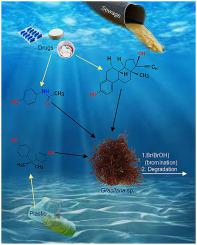Environmental Pollution ( IF 7.6 ) Pub Date : 2021-03-02 , DOI: 10.1016/j.envpol.2021.116853 Peleg Astrahan , Leor Korzen , Marina Khanin , Yoav Sharoni , Álvaro Israel

|
In the last few decades, Endocrine Disrupting Chemicals (EDCs) have taken significant roles in creating harmful effects to aquatic organisms. Many proposed treatment applications are time consuming, expensive and focus mainly on waste water treatment plants (WWTP), which are indeed a major aquatic polluting source. Nonetheless, the marine environment is the ultimate sink of many pollutants, e.g. EDCs, and has been largely neglected mainly due to the challenge in treating such salty and immense open natural ecosystems. In this study we describe the bromination and the yet unpresented degradation process of high concentrations (5 mg/L) of phenolic EDCs, by the marine red macroalgaeGracilaria sp. As shown, 17α-Ethinylestradiol (EE2), a well-known contraceptive drug, and one of the most persistent phenol EDCs in the environment, was eliminated from both the medium and tissues of the macroalga, in addition to the degradation of all metabolites as verified by the nil estrogenic activity recorded in the medium. Validation of the proposed bromination-degradation route was reinforced by identifying Bisphenol A (BPA) brominated degradation products only, following 168H of incubation in the presence of Gracilaria sp. As demonstrated in this assay for EE2, BPA and finally for paracetamol, it is likely that the phenol scavenging activity is nonspecific and, thus, possibly even a wider scope of various other phenol-based pollutants might be treated in coastal waters. As far as we know, Gracilaria sp. is the only marine sessile organism able of degrading various phenol based pollutants. The worldwide distribution of many Gracilaria species and their wide aquaculture knowhow, suggest that bioremediation based on these seaweeds is a possible cost effective progressive solution to the treatment of a wide scope of phenols at the marine environment.
中文翻译:

海藻快速EDC生物修复:红海藻Gracilaria sp。对EE2和BPA降解的支持证据,以及用于海洋传播的苯酚污染物的拟议模型
在过去的几十年中,内分泌干扰化学物质(EDC)在对水生生物产生有害影响方面发挥了重要作用。提议的许多处理应用都是耗时,昂贵的,并且主要集中在废水处理厂(WWTP)上,而废水处理厂的确是主要的水生污染源。尽管如此,海洋环境还是许多污染物(例如EDCs)的最终汇聚区,并且在很大程度上被忽略了,主要是因为在处理这种咸的和巨大的开放自然生态系统方面存在挑战。在这项研究中,我们描述了海洋红色大型藻类龙须藻对高浓度(5 mg / L)酚类EDC的溴化和尚不存在的降解过程。sp。如图所示,除了大型藻类的所有代谢产物降解外,还从大型藻类的培养基和组织中消除了一种众所周知的避孕药17α-乙炔雌二醇(EE2),也是环境中最持久的酚EDC之一。被记录在培养基中的零雌激素活性所证实。在Gracilaria sp存在下孵育168H之后,仅通过鉴定双酚A(BPA)溴化降解产物,可以加强对所建议的溴化降解途径的验证。如本实验对EE2,BPA以及对乙酰氨基酚的分析所证明的,苯酚清除活性可能是非特异性的,因此,在沿海水域中可能还会处理更广泛范围的各种其他基于苯酚的污染物。据我们所知,江蓠属。是唯一能够降解各种酚基污染物的海洋无柄生物。许多在全世界的分布龙须物种及其广泛的水产养殖技术诀窍,建议基于这些海藻是生物修复是一个可能的成本效益的逐步解决,在海洋环境中处理酚的范围很广的。









































 京公网安备 11010802027423号
京公网安备 11010802027423号